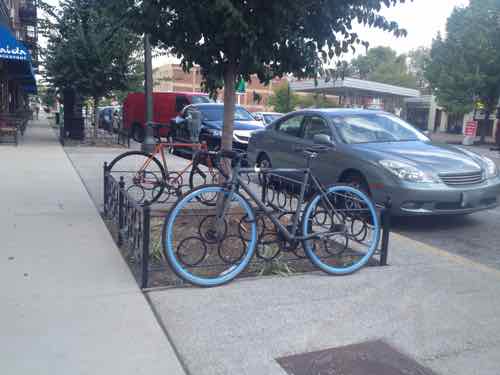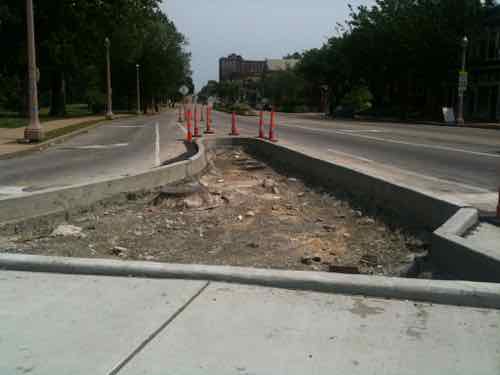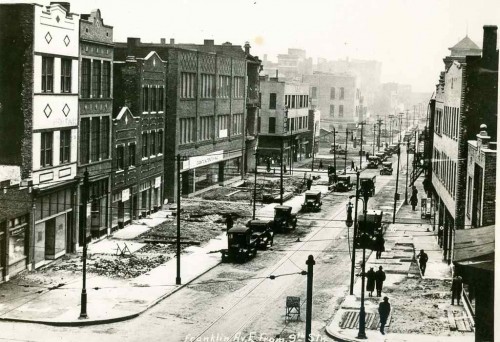Readers Have Positive Impression of South Grand Road Diet
A few years ago a few blocks of South Grand underwent a road diet:
In 2009, South Grand Boulevard was selected as one of four Great Streets Initiative pilot projects in the St. Louis region. Since 2006, East-West Gateway Council of Governments (EWG) has been helping communities in the St. Louis region expand the way they think about streets. Local leaders and citizens are encouraged to think beyond the curb to understand how transportation decisions affect the total built environment.
EWG recognizes the importance of streets as community resources and through the St. Louis Great Streets Initiative intends to make them more than just a conduit for cars. Great Streets in St. Louis will emphasize all modes of travel, especially walking. Great Streets will address and reconsider the auto- centric approach that has dominated design over the years in order to transform these streets into great community resources.
Considering how street design choices affect the pedestrian realm and abutting land uses is central to the St. Louis Great Streets Initiative. Connecting communities requires more than just installing a sidewalk along the edge of a busy street. It requires the careful and intentional creation of an environment that suits walking, bicycling and transit. It requires taming traffic in a way that still allows for mobility, but at speeds that are safe and undamaging. Streets traverse through communities and should do so in a way that enhances the community. (PDF — large file)
Now that the project has been completed I wanted to know how readers felt about it.


Here are the results from the Sunday Poll:
Q: Now that it has been in place a few years, what is your opinion of the South Grand ‘Great Streets’ road diet:
- Highly favorable 18 [45%]
- Favorable 12 [30%]
- Neutral 4 [10%]
- Tie 3 [7.5%]
- Unfavorable
- Highly unfavorable
- Unsure/No Answer 0 [0%]
As you can see, 75% have a positive view with only 15% a negative. I voted for “favorable”, some design decisions kept me from voting “highly favorable.” The pedestrian path still seems too narrow, for example.

We need more of these road diets to counter the massive road widening projects of the early 20th century! We have nowhere near the population that existed in those days, the road widening that took place is part of the reason for our population decline. We must remake our streets on the scale of a century ago — making them suitable for all modes (pedestrian, cyclist, motorist).
— Steve Patterson
The city just needs to make sure they look after the “rain gardens.” I recall these collecting rubbish and becoming over grown with weeds from time to time since going in.
Why is “the city” responsible, and not the adjacent property owner? (“The city” won’t cut my grass for me or shovel my sidewalk.)
Property owner or city, whoever is responsible needs to look after them.
I’ve noticed that on occasion as well. I believe the South Grand CID is responsible for the landscaping, etc., btw.
While I’m sure the plan was good for the South Grand area, did anyone check what was going on on the adjacent streets? I’ve heard there was a reduction in vehicles on Grand after the road diet, but did it correspond with an increase in the nearby street grid?
I’m not aware of more traffic diverted to side streets but if there is it doesn’t seem to rise to a level of neighborhood concern. (Potential through alternatives like Compton and Morgan Ford would still be longer and annoying than the bit of longer travel time drivers may be experiencing on S. Grand.) What will be interesting to see though is how streets will be impacted with the closure of the Kingshighway Viaduct next month.
Its fantastic (except for the pocket park which is kind of a joke). We need ten times more of it. Starting with Gravois, Jefferson and Broadway on the southside (khiway and hampton are a lost cause. Good riddance). Olive/lindell in central corridor. At least one, preferably all, could have a street car or at grade metro. Atleast bike lanes and speed and lane reductions.
The main reason Kingshighway and Hampton are lost causes is because of the people living in those areas. They don’t care; they have no vision; and, they don’t want “change”. So, yes. You’re correct. Those places are lost causes.
And why should they change, if it’s working, just fine, for them?! Their vision could very well be different from your vision – different, not better, not worse, just different. Why is there so much insistence on group think, that everyone must conform to one pure, “ideal”, dense(r) “urban” solution? If you don’t like the mid-century modern, quasi-suburban vibe of the city west of Kingshighway, just don’t go there, don’t live there, don’t spend your hard-earned money there – I doubt that you’ll be missed. Instead of dissing other people’s choices (to justify yours?), how about just focusing on why the South Grand project IS such a smashing success, and how to get the funding to do similar projects on those streets that you deem are “cool enough” to benefit from such investments, in neighborhoods of like-minded urbanistas.
Sure, it’d be great if we could do “ten times more of it”. But we also have this thing called a never-ending backlog of existing infrastructure needs, throughout the city, that need to be prioritized and met. And since it sounds like a CID was a critical component to the Grand project, how do we go about establishing “ten times more” CID’s, along other corridors? To take the lead on projects just like this one? In the immortal words of Jerry Maguire, “Show me the money!”
Successful? Look at the percent vacancy, speeding traffic, tanning stores, car accidents, fast food drive through restaurants, dangerous pedestrian crossings, etc. Restriping could save a lot, improve a lot, and cost a little.
And, has been noted with some of the new bike lanes around the city, restriping can be, and is, easily ignored by drivers who don’t want to change. Yes, paint is cheap, but part of what makes the South Grand project a success, both visually and functionally, is that it wan’t done “on the cheap”.
“Speeding traffic”, “car accidents” and “dangerous pedestrian crossings, etc.” are all directly related to how our police resources are prioritized. Yes, better urban design can help, but a major issue, in the city, is that few city police resources are (for valid reasons) directed at the enforcement of basic traffic laws, everything from speeding and rolling thru stop signs to jaywalking and drivers not respecting pedestrians in marked crosswalks. No, we don’t need predatory policing and speed traps, but some basic, on-going, roving, enforcement would go a long ways toward making the streets safer, once we get the increasing numbers of murders, assaults, robberies and burglaries under control . . . .
Do you actually ride in bike lanes? I recently switched from the bus to bike to get to work. While itsn ot perfct, the vast majority of motorists dont drive in them (im not sure what that even means, they usually arent wide enough for a car to drive in). Sometimes there is confusion dealing with right turns and motorists get over too early and violate the lane. Annoying but pretty avoidable. The new buffered lanes have markings that help with merging for right turns and they are a big improvement.
These days, I rarely use on-street bike lanes on major thoroughfares. I”d much rather either use off-street bike paths or parallel surface streets that have less traffic than the parallel arterials. Having ridden in urban traffic for 40+ years, I’ve become pretty adept at avoiding conflicts with motorists – they’re rarely worth the effort, the drama or the risk to my own well being . . . And I don’t doubt that the new bike lanes “are a big improvement” – anything would be – they’re just not something that I have a big need for, personally . . . .
Don’t worry, I don’t go there, the City, west of kinshighway, south of aresenal might as well be st louis county. It is a suburban hell hole (with the exception of macklind ave, ivanhoe ave, which has some potential, even City Watson rd isnt too bad). If they want to live like that fine, its too late now, I wish they had just moved to the county instead of suburbanizing the City, but that ship has sailed. They real problem is that this is where our city leaders live, the 91st muni in stl county, STL HIlls. Keep your suburban crap out of the urban core, but they only have a vision of making the City MORE like the County. They live next to it, they love it, they shop there, eat there, many work there and they want the City to be like the County. If they kept it in there little slice of suburbia down there it would be ok, but they impose their vision on the reast of the City, filling downtown with parkin lots and our real city neighborhoods with strip malls.
The truth of this comment is sublime. It needs to be a topic for a future Urban Review post. “St. Louis Hills: St. Louis City or St.Louis County? You make the call!”
EVERY city is made up of neighborhoods and commercial corridors of varying vintages and densities. Ever been to Queens or Staten Island in NYC? The south side of Chicago? Most parts of Tampa, Miami, Atlanta, Detroit, Nashville or Indianapolis? Anywhere outside of downtown Phoenix or LA? And every city limit is just an arbitrary line on a map – rarely does it follow a natural dividing line, unless it’s a major body of water. You may not like the urban fabric “west of kingshighway [or] south of arsenal”, but those areas ARE an integral part of the city, contributing residents, jobs, sales taxes and property taxes. But hey, if you think that the city would better served if it were broken up into multiple, smaller “cities”, much like the county, let’s have that discussion! I’m sure that there are more than a few south city residents that woud love to cut the ties to (and the responsibilities for) anything north of Delmar!
I know this, as a resident of STL Hills, we sure pay our share of taxes to the city of St. Louis. Our reassessment notices just arrived. The annual tax bill on a house worth around $300,000 just went from about $3,400 per year to about $3,800. Everyone on our block is getting an increase. Increases to pay for more cops, more park workers, more street paving, etc. In real estate taxes alone, the “non-city” city residents of our block pay somewhere near a combined $200,000 or more to the City of St. Louis. So you east of Kingshighway folks go ahead and feel all smug about St. Louis Hills not really being “in the city”, but the people in the Hills sure pay through the nose for the privilege of being your neighbor.
Thats one reason st louis is great. It isnt like those other cities, it is much more urban.
More urban than NYC or Chicago?!
Not as urban as the most urban parts of chicago. But chicago has more mid century suburban style neighborhoods in the city than st louis. On average I would say st louis is built in a more urban way (just comparing city to city, and chicago has big city limits). I dont enough about NYC, but ive seen parts of stateb island and queens that are pretty suburban. Alot of people think Manhattan is NYC, it aint, much of NYC (not th parts tourists go to) is built for cars as much as south hampton.
St. Louis Hills is pretty urban compared to places like Arnold and Fenton. You might not like St. Louis Hills very much, but I bet you like Arnold and Fenton even less! Am I right?
Yes
My guess is there is a direct correlation between when a city’s limit was “frozen” at some arbitrary point in time (if any) and how “urban” it is perceived to be now – If St. Louis city included the whole county, the ratio would be way different than it is now, not unlike many other cities who haven’t faced the same limitations.